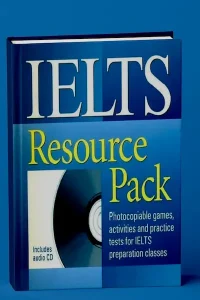Download IELTS Resource Pack (PDF+CD): Preparing students for the IELTS exam can become a grueling cycle of exam practice and intensive language analysis. Communication games and activities may be available, but with the exam approaching, it can seem inappropriate to spend time on anything not directly relevant to the exam.
Also Read: IELTS Vocabulary By Topics
IELTS Resource Pack (PDF+CD)
Preparing classes for the IELTS exam can be hard work for both teachers and students, with lessons often settling into a gruelling cycle of exam practice and intensive language analysis. Games and communication activities may be available, but with the exam approaching it can seem inappropriate to spend much lesson time on anything which is not directly relevant to IELTS.
The games and activities in this book aim to help with this dilemma. They are fun, motivating and in many cases kinaesthetic (i.e., students use their bodies as well as their minds), yet they all relate directly to the exam, in many cases actually using the formats from the exam.
There are activities based on the formats of each part of the Listening, Academic Reading, Academic Writing and Speaking papers of the exam.
Level
IELTS candidates cover a broad range of levels, with candidates from intermediate to advanced levels taking the exam and receiving a grade which is satisfactory for their purposes. The level of each activity in this book is indicated as follows:
- IELTS 5 —7:
suitable for the majority of students preparing for the exam, induding lower-level IELTS candidates, and students at the beginning of an IELTS course. - IELTS 6 and above:
primarily aimed at rniddle and higher-level candidates, but may be approachable by lower-level candidates as well.
Academic and General versions of the exam
The majority of candidates take the Academic version of the exam, and the activities in this book are based on that version. General versions of the Reading and Writing Papers are also available.
The Reading section activities in this book may be useful to General version candidates, as the question formats are simflar. The Writing activities will be less useful, as General version candidates are not required to write in an academic style.
Choosing an Activity
The activities are not arranged in any particular order within each section. The easiest way to link them with your course material is probably by exam focus — for example, if part of a lesson focuses on Academic Writing Task 2, you could expand on that with an Academic Writing Part 2 activity from this book. The level of difficulty of the activity will also be a factor, of course — see the paragraph on level above.
Setting up an Activity
To make sure that everybody understands the format of an activity, it can be a good idea to begin with a demonstration rather than an explanation. Join one pair/group/team, and begin the activity while the rest of the class watches.
Tell the class that the activity is directly linked to the exam, and that the skills they will use to complete it are skills they will need in the exam.
Doing an Activity
When everybody is clear about the task, and has begun, visit each group/pair/team as soon as possible, just to check that everything is going well. After this initial round, visit each group/pair/team for longer. Check for language difficulties, and help any students who are having problems.
While you are doing the things listed above, make a mental or written note of any problems with pronunciation, grammar and vocabulary.
Doing an activity
When everybody is clear about the task, and h. begun, visit each group/pair/team as soon as possible, just to check that everything is going well. After this initial round, visit each group/pair/team for longer. Check for language difficulti., and help any students who are having problems.
While you are doing the things listed above, make a mental or written notc of any problems with pronunciation, grammar and vocabulary.
After an Activity
Use the information you gathered while monitoring to practise problem areas and/or to plan future lessons which address the problems you encountered.
Elicit feedback from the class. Did they think the activity was useftil? What did they learn? What aspects of it were difficult?
Follow-up
activities The teaching notes for each activity include suggestions for follow-up activities. These are entirely optional.
Follow-up activities
The teaching notes for each activity include suggestions for follow-up activities. These are entirely optional.
Practice Tests
Section 2 of this book features two practice tests which closely reflect the types of question and level of the IELTS exam. When using practice test material such as this, it is a good idea to recreate exam conditions as closely as possible. If there is space in the classroom, seat students with at least a metre between each one. There should of course be no communications between students while the test is in progress. It is essential to keep to the same timings as the exam.
Please note that the instructions for the Reading papers refer to writing on an Answer sheet. The students do this in the actual exam but not in these Practice Tests.
The recordings for the Listening section can be found on the CD that accompanies this book.


